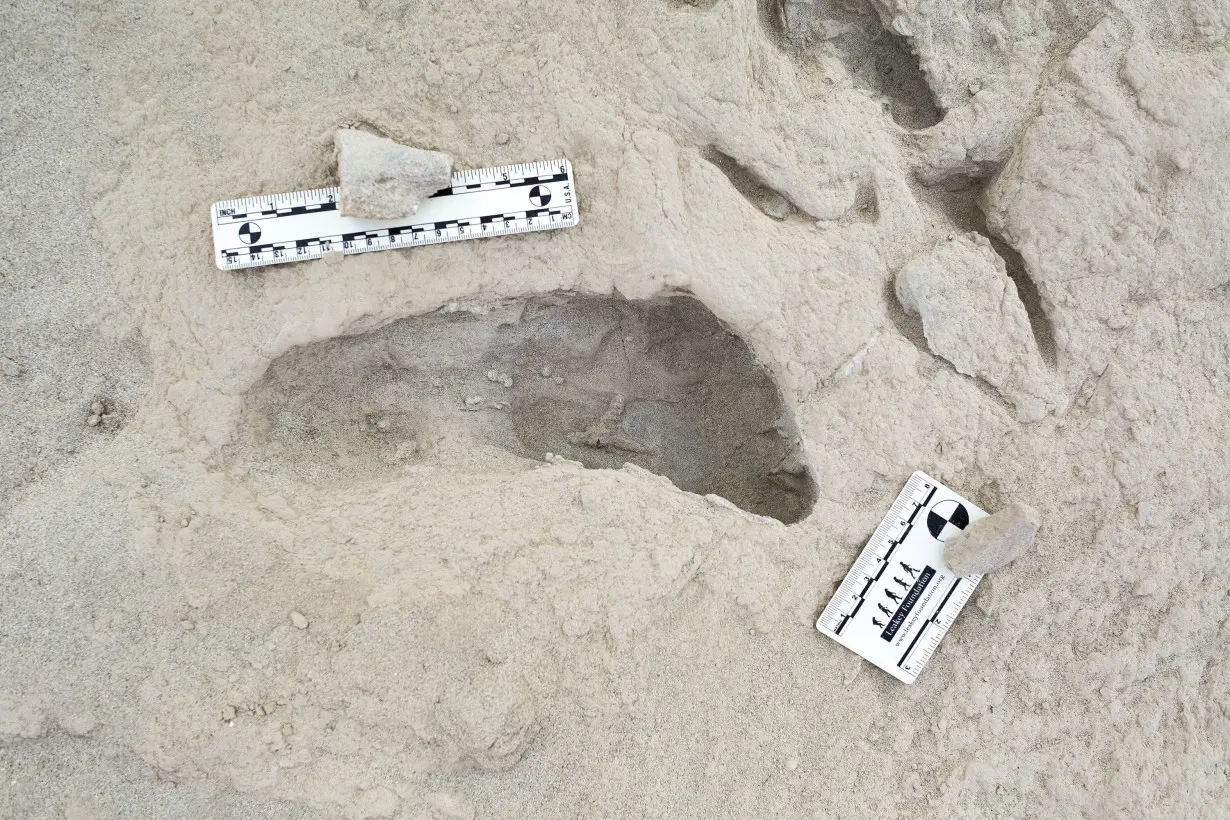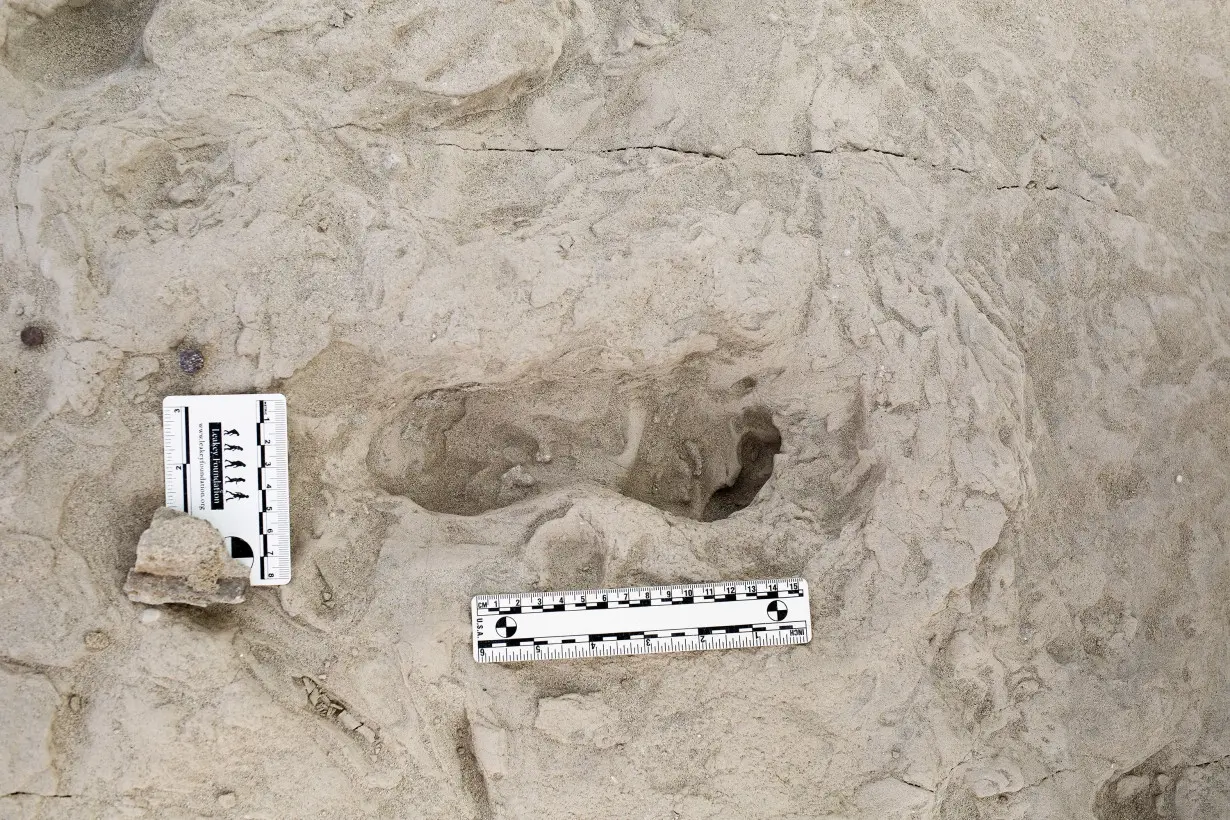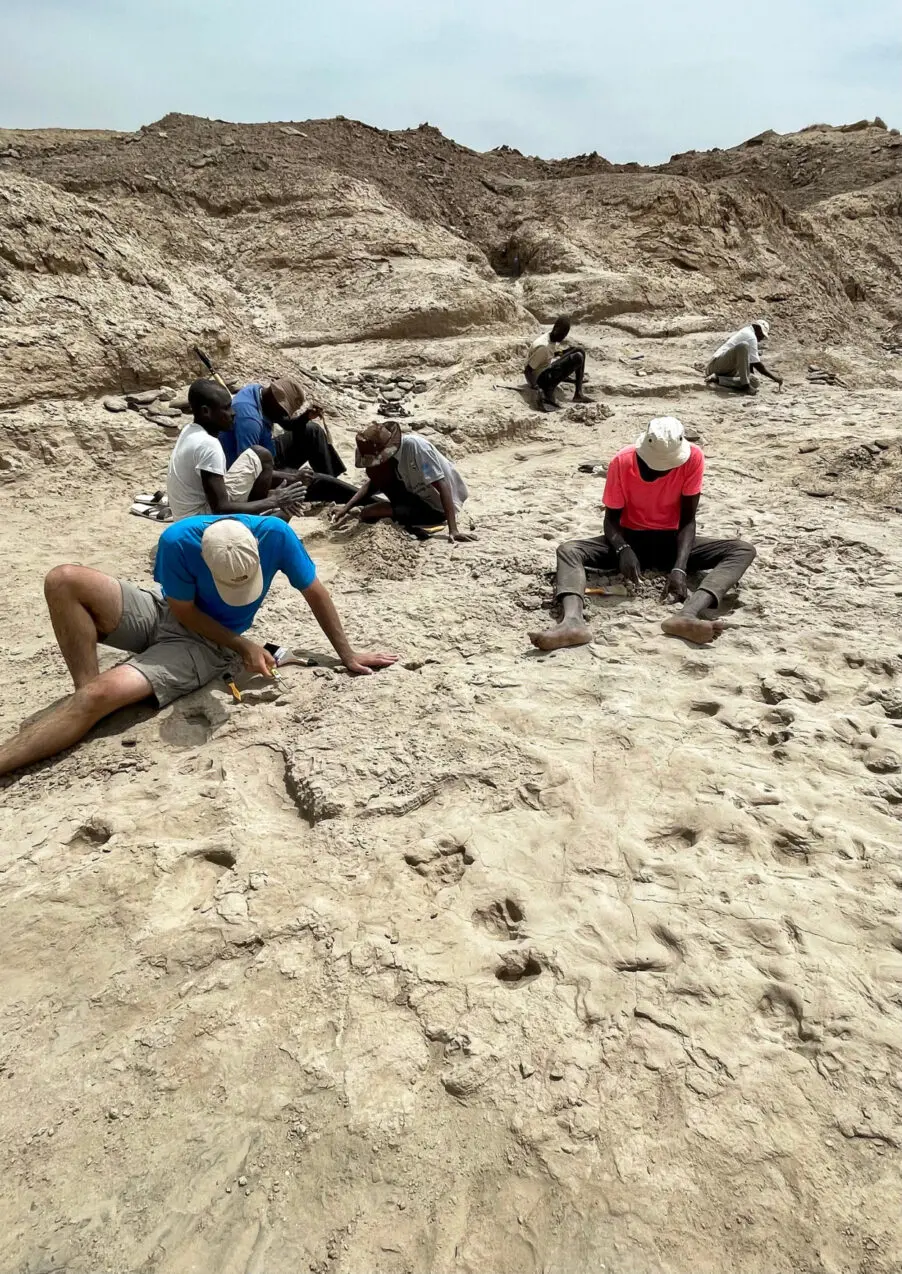(CNN) — More than 1.5 million years ago, two different species of ancient human crossed paths on a lakeshore, perhaps locking eyes with each other. These early forerunners of Homo sapiens wandered in a landscape teeming with wildlife, including giant maribou storks that stood 2 meters (6.5 feet) tall.
A stunning discovery of fossilized footprints pressed into soft mud preserved the unexpected and extraordinary moment, suggesting that the two distinct types of hominin were able to live as neighbors sharing a habitat, rather than as competitors who kept to their own territory.
“It’s surprising that you would have two kinds of similarly sized, large-bodied hominin species on the same landscape,” said Kevin Hatala, first author of a study on the footprints that published in the journal Science on Thursday.

“We see them in the very same lake margin environment, passing within this area within hours to a couple of days of one another. They probably would have been aware of each other’s existence. They saw each other and they might have interacted,” added Hatala, who is an associate professor of biology at Chatham University in Pittsburgh.
The first part of the find occurred in July 2021 during an excavation at Koobi Fora, on the eastern shore of Lake Turkana in Kenya, where the skeletal remains of several ancient human relatives have been found. That excavation revealed one hominin footprint, alongside several other tracks made by large birds. The team decided to rebury the tracks with fine sand until a detailed excavation was possible.
The dig took place in 2022, when Hatala and his colleagues exposed 23 square meters (248 square feet) of sediment, revealing 11 more hominin tracks similar to the first in a line that suggested they were made by the same individual, plus three isolated footprints that were oriented in a perpendicular direction.
The researchers also found 94 nonhuman tracks belonging to birds and cow- and horse-like animals. The largest bird track was 27 centimeters (10.6 inches) across and likely belong to a kind of giant stork known as Leptoptilos.

“There’s one long trackway with 12 (hominin) footprints in it. It was made at a decent walking pace … especially since they were walking through mud. There’s not a clear destination at the end,” Hatala said.
“It’s hard to say what exactly they were doing, but they walked in that perfect zone of mud,” he said. “If you think about the shoreline of a lake or a modern beach, you’ve got kind of a narrow zone where the mud is perfect for making footprints. If you move too far this way, it’s too dry, if you move too far the other way, it’s too wet. And they’re walking almost like in a straight line through the perfect area for their footprints to be made, which is very lucky for us,” he said.
The three other footprints perpendicular to the trackway were scattered across the site. Hatala thinks they were made by three separate individuals, their other tracks perhaps wiped out by other animals walking around the surface at the same time.
Pristinely preserved
Hatala and his colleagues couldn’t directly date the footprints. But Hatala said the fossils were found below — and therefore were “slightly older” than — a layer of volcanic ash on the same site known as Elomaling’a Tuff, which has been dated to 1.52 million years ago, according to the study.
However, the researchers said they are confident that the tracks were imprinted within hours to a few days of one another because there is no cracking on the surface of the footprints, which would be the case if they were exposed to air and dried under the sun for a longer period.
Instead, the scientists said the prints were all pristinely preserved in a similar fashion under the accumulating strata of sediment, thanks to fine and silty sand that gently covered the tracks soon after they had formed.
“This was probably a delta system, with lots of shallow, low-energy water in this area and lots of nice muds,” Hatala said.
The term hominin refers to all species in the human family tree that emerged after the split from the ancestors of the great apes 6 million to 7 million years ago. This group includes more recently extinct species such as Neanderthals, which disappeared 40,000 years ago, and Australopithecus afarensis, represented by the famous Lucy skeleton in Ethiopia, which was 3.2 million years old.
Homo sapiens, our own species, is the only living type of hominin, making the idea of encountering another species from the same lineage particularly tantalizing to imagine. The researchers found some clues as to which groups of ancient humans crossed paths during this encounter.
Who did the footprints belong to?
The team concluded that hominins belonging to the species Homo erectus and the smaller-brained Paranthropus boisei made the footprints. P. bosei made the long trackway, while Homo erectus made the other three footprints, the study suggested. The skeletal remains of both species have been found at the site.
However, it wasn’t immediately obvious that the footprints were made by two different species. Hatala, who is an expert in foot anatomy, determined they reflected different patterns of gait, stance and motion only after detailed 3D imaging and analysis.
Through experiments in the field and in the lab, he compared the footprints with those made by living humans, including 59 of the Daasanach people in Ethiopia, who typically don’t wear shoes, as well as other fossilized hominin prints and tracks made by chimpanzees.
Hatala found that the 12-print trackway was made by an individual whose footprints didn’t fall within the range of variation seen in Homo sapiens, unlike the three scattered footprints, which plotted more closely to those made by living humans.
“Homo erectus, from the neck down, they look very similar to modern humans, and within this time period, they are the best candidate for being a direct ancestor of ours. We hypothesize that those more humanlike footprints are more likely Homo erectus just because the rest of their anatomy is so human,” Hatala said.
“Paranthropus boisei, they look quite different. Most of the fossils that are confidently attributed to them are skulls or teeth. They have very large jaws, very large teeth and large attachments for chewing muscles. It looks like they adapted to eating a very different kind of diet than Homo erectus,” he said. Hatala explained that Bosei likely ate a plant-based diet, whereas Homo erectus was more of an omnivore.
Hatala and his colleagues reviewed old fossil data from the site and found evidence the two species overlapped at the site for a significant period of time — perhaps over the course of 100,000 years, he said.
“That’s exciting to see and to us that implies that direct competition between the two of them must have been relatively low, that they must have been OK with one another living on the same landscape. They weren’t driving each other out,” he said.
“It would have been a risky area, there would have been hippos, crocodiles, other sorts of dangerous animals that were living in those areas, too,” Hatala added. “So there must have been some appeal for both of them to go to those areas repeatedly over such a long time.”
The footprints are the first physical proof that different hominin species overlapped in exactly the same time and space, dodging predators and finding food in the ancient landscape, according to the study. Homo erectus went on to thrive for 1 million years more. Paranthropus boisei, however, went extinct within the next few hundred thousand years. Scientists don’t know why.
Briana Pobiner, a research scientist and museum educator at the Smithsonian National Museum of Natural History’s Human Origins Program, said it was “mind-blowing” to find footprints of not just one but two species walking in the same area.
“Maybe, they actively competed for the same food; maybe they just eyed each other warily from across a grassy patch. Maybe they ignored each other entirely,” said Pobiner, who was not involved the new research.
While it’s the first time that footprints have suggested hominins of two species directly encountered one another, genetic evidence has revealed that Neanderthals interbred with Homo sapiens and Denisovans, a little understood hominin only known from a scant few fossils. Denisova Cave in Siberia was home to a girl who had a Neanderthal mother and a Denisovan father.
Maybe, Pobiner said, P. boisei and H. erectus “were similar enough that they even mated with each other on occasion.”
“This finding tells us that they lived in the same place, at the same time, and walked around practically next to each other,” she said.
“It’s impossible to go back in time to actually observe these species 1.5 million years ago — but having both of their footprints on the same surface? That’s the next best thing.”
The-CNN-Wire
™ & © 2024 Cable News Network, Inc., a Warner Bros. Discovery Company. All rights reserved.

 Trump has begun another trade war. Here's a timeline of how we got here
Trump has begun another trade war. Here's a timeline of how we got here
 Canada's leader laments lost friendship with US in town that sheltered stranded Americans after 9/11
Canada's leader laments lost friendship with US in town that sheltered stranded Americans after 9/11
 Chinese EV giant BYD's fourth-quarter profit leaps 73%
Chinese EV giant BYD's fourth-quarter profit leaps 73%
 You're an American in another land? Prepare to talk about the why and how of Trump 2.0
You're an American in another land? Prepare to talk about the why and how of Trump 2.0
 Chalk talk: Star power, top teams and No. 5 seeds headline the women's March Madness Sweet 16
Chalk talk: Star power, top teams and No. 5 seeds headline the women's March Madness Sweet 16
 Purdue returns to Sweet 16 with 76-62 win over McNeese in March Madness
Purdue returns to Sweet 16 with 76-62 win over McNeese in March Madness








